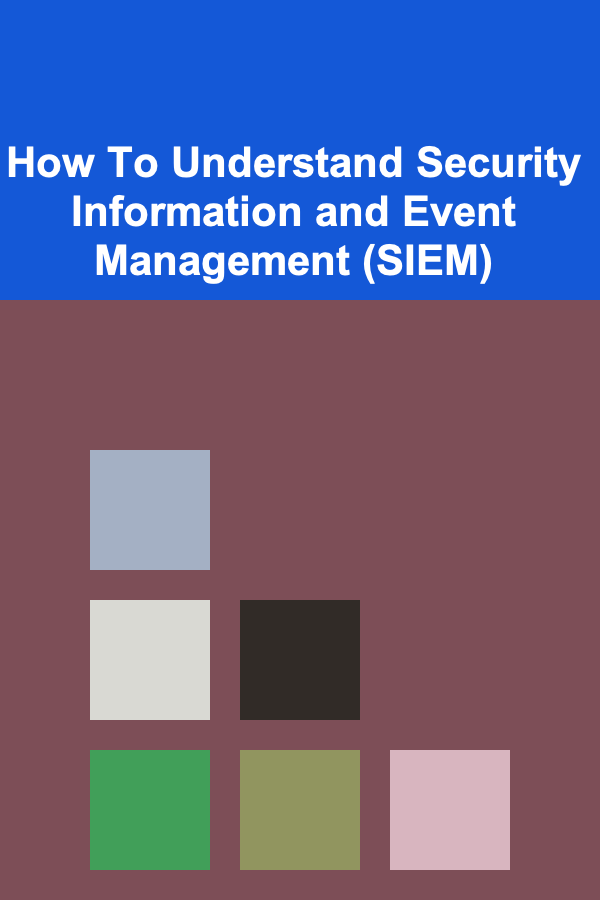
How To Understand Security Information and Event Management (SIEM)
ebook include PDF & Audio bundle (Micro Guide)
$12.99$7.99
Limited Time Offer! Order within the next:

In the ever-evolving landscape of cybersecurity, one of the most vital tools for protecting an organization's digital assets is Security Information and Event Management (SIEM). A SIEM system plays a critical role in detecting, monitoring, and responding to potential threats in real time, ensuring that an organization's network and data are secure. However, understanding the inner workings of SIEM can be complex, especially for those new to the field or looking to deepen their knowledge.
This article will explore the core concepts behind SIEM, how it functions, its components, benefits, and challenges, and its role in modern cybersecurity infrastructures. By the end of this article, readers will have a comprehensive understanding of SIEM and its importance in safeguarding digital environments.
What is SIEM?
Security Information and Event Management (SIEM) is a cybersecurity solution that provides real-time monitoring, analysis, and reporting of security-related events within an IT environment. SIEM systems aggregate data from various sources, such as security appliances, networking devices, servers, and applications, to provide security teams with a holistic view of their organization's security posture.
SIEM operates by collecting log and event data from different sources across the network, normalizing it for analysis, and then correlating this information to identify patterns or anomalies that could indicate potential security incidents. The system then generates alerts or triggers automated responses based on pre-configured rules and thresholds.
The Key Components of a SIEM System
A SIEM system consists of several core components that work together to detect, monitor, and respond to security events effectively. These components include:
1. Data Collection
The first step in a SIEM system is collecting security data from various sources. This data can include logs, events, and security alerts from firewalls, intrusion detection systems (IDS), routers, servers, and applications. SIEM systems can pull this data in real-time or batch mode, depending on the organization's requirements.
Data sources typically include:
- Security Devices: Firewalls, intrusion detection/prevention systems (IDS/IPS), endpoint security solutions, and more.
- Network Devices: Routers, switches, and load balancers.
- Servers: Web servers, email servers, database servers, etc.
- Applications: Business-critical applications, databases, and other software solutions.
- Cloud Services: Many organizations also use cloud environments, and SIEM systems must integrate with cloud-based services like AWS, Azure, and Google Cloud Platform.
2. Data Normalization
Once the data is collected, it must be normalized. This means converting various formats and structures of incoming data into a consistent format that the SIEM system can easily analyze. Data normalization ensures that disparate log formats (such as syslog or Windows Event logs) are transformed into a unified format, making the analysis process more efficient.
3. Event Correlation
Event correlation is one of the most powerful features of a SIEM system. It involves analyzing the normalized data to identify relationships between different events that may point to a security incident. For example, a failed login attempt followed by a successful login could indicate a brute-force attack or unauthorized access.
By correlating events from different sources, SIEM systems can:
- Detect complex attacks that span multiple systems.
- Identify patterns of malicious behavior that may not be immediately obvious.
- Reduce false positives by understanding the context of an event.
4. Alerting and Notification
Once suspicious activity is detected, the SIEM system generates alerts and notifications to security teams. These alerts typically include details about the event or incident, such as the affected system, the type of attack, and any relevant context. SIEM alerts can be customized to suit the organization's security policies and priorities.
Alerts can be triggered based on predefined rules, thresholds, or machine learning models that detect anomalous behavior. The goal is to provide security teams with actionable information to respond to potential threats quickly.
5. Analysis and Reporting
SIEM systems also provide powerful analytical capabilities that help security professionals investigate incidents, perform forensics, and gain insights into their network's security posture. This can include real-time dashboards, historical data analysis, and custom reporting.
Security teams can use the reports generated by SIEM systems to:
- Perform threat hunting to proactively identify threats.
- Analyze attack trends over time to refine security policies.
- Generate compliance reports for regulatory requirements, such as GDPR or HIPAA.
6. Incident Response and Automation
SIEM systems can be integrated with incident response (IR) tools to automate the response to certain types of security events. This could include blocking IP addresses, isolating infected devices, or triggering predefined workflows for further investigation.
The ability to automate responses allows organizations to react more quickly to incidents, reducing the time between detection and mitigation. Automation also helps mitigate human error and improves overall security posture.
The Role of SIEM in Cybersecurity
SIEM systems play a pivotal role in modern cybersecurity strategies. Here are some of the primary ways in which SIEM contributes to the protection of an organization's digital infrastructure:
1. Real-Time Threat Detection
SIEM systems provide real-time monitoring, enabling security teams to detect threats as they occur. By correlating data from multiple sources, SIEM systems can identify suspicious behavior such as unauthorized access attempts, data exfiltration, or malware activity. Real-time detection is crucial for minimizing the damage caused by cyberattacks.
2. Centralized Visibility
SIEM offers centralized visibility into an organization's entire IT infrastructure. Security teams can monitor activities across servers, endpoints, network devices, and cloud environments from a single dashboard. This holistic view helps detect cross-platform threats that may not be visible when monitoring individual components in isolation.
3. Incident Investigation and Forensics
When a security event occurs, a SIEM system provides detailed logs and context that help investigators understand the nature of the attack. Security teams can trace the origins of the attack, the tactics used by attackers, and the systems affected. This forensic analysis is crucial for post-incident response and learning from past incidents.
4. Compliance and Regulatory Reporting
Many industries are subject to strict regulatory requirements, such as PCI-DSS, HIPAA, and GDPR, which mandate that organizations maintain detailed logs of their security activities. SIEM systems help organizations stay compliant by automating log collection, analysis, and reporting. They can generate reports that demonstrate compliance with regulatory standards, making it easier to pass audits and reduce the risk of fines.
5. Proactive Threat Hunting
SIEM systems also play a role in proactive security measures, such as threat hunting. By continuously analyzing network traffic and logs for unusual patterns, security teams can identify threats before they result in actual damage. This proactive approach helps identify new attack vectors and strengthens the organization's overall security posture.
Benefits of SIEM
Implementing a SIEM system provides a wide range of benefits, including:
1. Enhanced Threat Detection
With real-time monitoring and event correlation, SIEM helps detect security incidents faster, allowing organizations to mitigate threats before they cause significant damage.
2. Improved Incident Response
SIEM systems help organizations respond to incidents more efficiently by providing actionable insights and automated responses. This reduces the time to detection and resolution.
3. Reduced Operational Costs
By automating many of the processes related to security monitoring, data collection, and reporting, SIEM systems help reduce the workload of security teams. This leads to cost savings in terms of labor and resources.
4. Compliance Automation
SIEM simplifies the process of maintaining compliance with various regulations by automating log collection, retention, and reporting.
5. Better Decision-Making
The rich data and insights provided by SIEM systems enable better decision-making for security teams. Security professionals can make informed decisions based on a comprehensive understanding of network activity and potential risks.
Challenges of SIEM
Despite its many benefits, SIEM systems are not without their challenges. Some common challenges organizations face when implementing and managing SIEM systems include:
1. High Cost of Implementation
The initial cost of implementing a SIEM system can be significant, especially for smaller organizations. In addition to the software costs, there may be expenses related to hardware, training, and ongoing management.
2. Complexity and Maintenance
SIEM systems are complex and require ongoing management, including tuning rules and managing the data storage. Without proper expertise, organizations may struggle to get the full value from their SIEM investment.
3. False Positives
One of the most common challenges with SIEM is dealing with false positives. With so much data coming from various sources, it can be difficult to separate benign activity from actual threats. This leads to alert fatigue, where security teams may overlook important alerts due to an overwhelming number of notifications.
4. Scalability
As organizations grow, their SIEM systems must scale to handle increased data volume. Scaling a SIEM system can be costly and technically challenging, particularly for organizations that are expanding into cloud environments.
Conclusion
Security Information and Event Management (SIEM) is an essential component of modern cybersecurity infrastructures. By providing real-time monitoring, event correlation, and incident response capabilities, SIEM helps organizations detect, respond to, and mitigate security threats before they cause significant damage. However, SIEM systems come with challenges, such as complexity, high costs, and the need for ongoing tuning to reduce false positives.
As cyber threats continue to grow in sophistication, SIEM will remain a critical tool for protecting organizations' digital environments. Understanding the key components, benefits, and challenges of SIEM is the first step toward effectively leveraging this powerful technology to enhance your organization's security posture.

Building an Engaging Content Portfolio as a Content Editor
Read More
How to Design a DIY Advent Calendar for a Fun Holiday Tradition
Read More
How to Reorganize Your Bathroom for Better Space Efficiency
Read More
How to Start Investing with a Small Budget
Read More
How to Use Furniture Layout to Create Flow in Small Homes
Read More
How to Animate Simple Graphics in Illustrator
Read MoreOther Products

Building an Engaging Content Portfolio as a Content Editor
Read More
How to Design a DIY Advent Calendar for a Fun Holiday Tradition
Read More
How to Reorganize Your Bathroom for Better Space Efficiency
Read More
How to Start Investing with a Small Budget
Read More
How to Use Furniture Layout to Create Flow in Small Homes
Read More